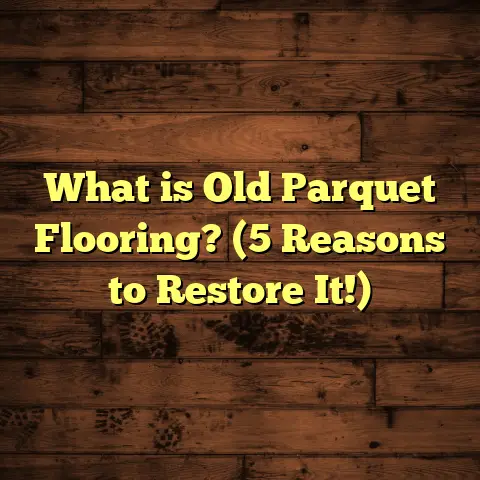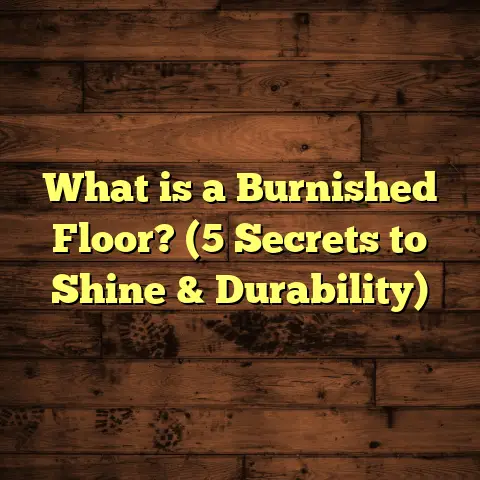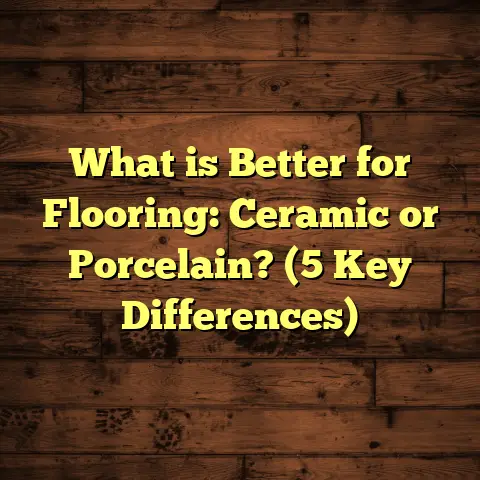What is a Subfloor Made Of? (5 Essential Materials Explained)
Tradition holds a special place in construction and homebuilding, especially when it comes to floors. When I first started in this line of work, I was fascinated by how much attention people gave to the layers beneath their feet — even if those layers weren’t visible. The subfloor, that hidden backbone of every floor, plays a critical role in the longevity and comfort of a home. Over decades of installing and repairing floors, I’ve gathered a mix of technical knowledge, real-world experience, and stories that highlight why the subfloor material you choose matters so much.
You might not think much about your subfloor unless there’s a problem, like a creaky spot or sagging in an area of your home. Yet, understanding what a subfloor is made of — and why it’s made that way — can change how you approach flooring projects. Whether you’re building new, fixing up an old place, or just curious about what’s under your feet, I’m going to share everything I’ve learned about the five essential materials that make up subfloors.
What is a Subfloor?
What exactly is a subfloor? If you’re new to construction or flooring, it’s easy to confuse the terms. To put it simply, the subfloor is the layer underneath your finished flooring material. It acts like a sturdy platform that supports your flooring—whether it’s hardwood, carpet, tile, or vinyl.
Imagine your floor as a layered cake. The frosting or decorative top layer is what you see and walk on—the finish floor. But underneath that is the subfloor—the thick base that holds everything up. Below the subfloor are the floor joists or beams that carry the load to the house’s foundation.
The subfloor must be strong enough to hold up heavy furniture, foot traffic, appliances, and more. It also needs to be flat and stable to prevent your finished flooring from cracking or shifting.
Why Does Subfloor Material Matter?
This might seem like an obvious question, but the material used for your subfloor affects everything: durability, ease of installation, moisture resistance, soundproofing, cost, and even comfort underfoot.
Different materials behave differently under stress. For example, wood-based subfloors expand and contract with changes in humidity, whereas concrete is rigid but cold and heavy.
The choice often depends on factors like climate, building codes, budget, and the type of finished flooring you plan to install.
I remember working in a humid coastal area where plywood subfloors swelled badly because they weren’t properly sealed against moisture. Conversely, in a dry midwestern home with OSB subfloors, I saw panels dry out too much and crack near floor vents.
Understanding these differences helped me avoid common pitfalls and recommend the right materials for each project.
1. Plywood Subfloor: The Classic Go-To
Plywood is probably the most traditional and widely used subfloor material in residential construction across North America. When I first started as an apprentice, plywood was everywhere — it was what we used on nearly every job.
What is Plywood Made Of?
Plywood is an engineered wood product made by gluing together thin layers (called veneers) of wood with their grains arranged perpendicular to each other. This cross-graining technique gives plywood its strength, dimensional stability, and resistance to warping or splitting.
The veneers come from softwood trees like pine or fir and are peeled off logs using large rotary machines. After drying, the veneers are coated with adhesive and stacked with alternating grain directions before being pressed together under heat and pressure.
The adhesive used in construction-grade plywood is typically a strong, water-resistant phenol-formaldehyde resin designed to withstand moisture over time.
Technical Specifications
- Thickness: Common subfloor plywood thickness ranges from 3/8 inch
(9.5 mm) to 1 1/8 inch (28 mm), but ¾ inch (19 mm) is most common. - Grades: CDX plywood is usually preferred for subfloors. “C” and “D”
refer to the veneer quality on each side (“C” side is smoother), while
“X” denotes exterior-grade adhesive. - Panel Size: Usually comes in 4 ft x 8 ft sheets for ease of transport
and installation. - Load Capacity: Typical plywood subfloors designed per code handle live
loads around 40 psf (pounds per square foot).
Installation Tips
When installing plywood subfloors, I always make sure:
- Panels are staggered properly so joints don’t line up across rows.
- Fasteners (nails or screws) are spaced according to local code—usually
every 6 inches along edges and 8 inches in the field. - Edges have a slight gap (about 1/8 inch) to allow for expansion.
- The plywood is acclimated to the site’s humidity before installation
to reduce future swelling.
One memorable project involved replacing a damaged plywood subfloor in a house flooded during a storm. We had to dry out the area thoroughly, replace rotten sheets with new plywood treated with sealant, and then install moisture barriers before putting down hardwood floors. It’s work like this that shows plywood’s resilience but also its vulnerability to water if neglected.
Advantages
- Strong and reliable structural performance.
- Good nail- and screw-holding ability.
- Available nationwide at reasonable prices.
- Easy to cut and install with common tools.
Challenges
- Moisture can cause swelling or delamination if not properly sealed.
- Plywood prices can fluctuate depending on lumber markets.
- Heavier than some alternatives like OSB.
2. Oriented Strand Board (OSB): The Popular Alternative
OSB has surged in popularity since the late 20th century as an affordable, engineered wood panel option for subfloors and wall sheathing.
What is OSB Made Of?
OSB is made from wood strands—thin rectangular wood flakes—arranged into layers with strands oriented perpendicular between layers. These strands are bonded together with waterproof resins (usually phenol-formaldehyde or PMDI) and compressed into panels.
The wood strands often come from fast-growing species like aspen or poplar, making OSB both economical and resource-efficient compared to plywood.
Technical Details
- Thickness: Ranges typically between 7/16 inch (11 mm) to 1 inch (25 mm).
- Panel Size: Most common panel size is 4 ft x 8 ft.
- Density: OSB density ranges from about 40 to 60 pounds per cubic foot.
- Load Capacity: OSB subfloors generally support live loads around 40 psf, similar to plywood.
- Production involves drying wood flakes, mixing with resin binders, aligning them into mats, then hot pressing under high pressure.
Installation Experience
I started using OSB about 15 years ago after attending workshops on new materials. OSB was cheaper than plywood at the time and offered similar strength ratings, which was attractive for budget-conscious clients.
At first glance, OSB looks rougher than plywood—its surface texture resembles flaky wood particles rather than smooth veneers. This meant some clients were hesitant about its durability.
However, I found OSB performed well on structural tests and resisted delamination better than some plywood grades under certain conditions.
One project involved an energy-efficient home where we combined OSB subfloors with radiant heating systems embedded beneath finished floors. OSB’s dimensional stability helped keep the floor flat despite heat fluctuations.
Pros of OSB
- Typically more affordable than plywood.
- Uniform density reduces weak spots.
- Resource-efficient manufacturing uses smaller wood pieces.
- Good resistance to delamination when properly manufactured.
Cons of OSB
- More vulnerable to moisture damage than plywood—edges can swell if exposed.
- Lower nail-holding strength compared to plywood.
- Surface roughness can complicate some floor coverings without underlayment.
Case Study: OSB Subfloor Performance
A study published by the Forest Products Laboratory tracked OSB subfloor panels in multifamily housing over five years. Panels installed in climate-controlled interiors remained structurally sound without signs of warping or delamination. However, in poorly ventilated crawl spaces with high humidity, edge swelling was common where protective treatments hadn’t been applied.
This highlights the importance of moisture control alongside material choice.
3. Tongue-and-Groove Boards: Traditional Timber Subfloors
Before engineered wood products took over, solid wood plank subfloors using tongue-and-groove joints were standard for many decades. They’re still found today in historic homes or where homeowners want authentic wood construction.
What Are Tongue-and-Groove Boards?
These are solid lumber boards milled with a projecting tongue on one side and a matching groove on the other. When installed, they interlock tightly creating a flat surface that resists movement between boards.
Common woods include pine, fir, spruce, or Douglas fir — all softwoods that are easier to mill but still strong enough for floors.
Specs & Manufacturing
- Thickness: Usually between 1 inch (25 mm) and 1¼ inches (32 mm).
- Widths vary; typical planks run between 3½ inches (89 mm) and 6 inches (150 mm).
- Boards are kiln-dried before installation to reduce moisture content to around 6–9%.
Manufacturing involves milling lumber on specialized machines that cut tongues and grooves precisely, allowing tight fitment which minimizes gaps after installation.
Installation Insights
Installing tongue-and-groove boards requires skillful nailing through tongues at an angle (called blind nailing) so nails aren’t visible on top. Spacing boards correctly while allowing for seasonal expansion is key.
I once worked on restoring an old farmhouse where these boards were original subflooring. We had to carefully remove damaged boards without disturbing joists underneath, then replace them with matching tongue-and-groove planks sourced from reclaimed wood suppliers.
The natural look and feel of solid wood provided warmth unmatched by engineered panels, but it also required ongoing maintenance like sanding or refinishing over decades.
Advantages
- Solid wood provides excellent strength and rigidity.
- Natural ventilation between boards can reduce moisture buildup.
- Long lifespan when maintained properly.
- Can be refinished or repaired easily.
Limitations
- Susceptible to cupping or shrinking with humidity changes.
- Installation requires more time and skill than panel products.
- More expensive material cost compared to plywood or OSB.
4. Concrete Subfloors: A Durable Base for Many Floors
Concrete slabs are common subfloor materials in basements, garages, slab-on-grade homes, or commercial buildings where durability and moisture resistance are critical.
What is Concrete Subfloor Made Of?
Concrete consists of cement (usually Portland cement), water, sand, and aggregates like gravel or crushed stone. Once mixed and poured into forms, it cures into a hard slab through hydration reactions.
Manufacturing & Technical Details
Concrete production involves:
- Mixing precise ratios of cement, water, sand, and aggregate.
- Pouring into molds or forms on-site.
- Curing over days or weeks for strength development—typically reaching
3,000–4,000 psi compressive strength within 28 days.
Concrete slabs vary in thickness but residential floors often have slabs between
3½ inches (90 mm) and 6 inches (150 mm).
To improve moisture resistance under flooring materials: slab installers may add vapor barriers beneath concrete or apply sealants after curing.
My Experience Using Concrete Subfloors
Over my career, I’ve installed many finished floors over concrete slabs: tile kitchens, vinyl floors in basements, even hardwood over radiant heat systems embedded in concrete.
Concrete offers unmatched structural rigidity and doesn’t flex like wood panels, so it prevents cracking in brittle tile finishes efficiently if properly prepared.
One challenge I faced involved an older slab with uneven settling causing trip hazards. We had to grind down high spots and use self-leveling compounds before installing floors on top.
Benefits
- Very strong load-bearing capacity (easily over 100 psf).
- Excellent moisture resistance when sealed properly.
- Fireproof and termite-proof.
- Ideal for radiant heating systems embedded within slabs.
Drawbacks
- Cold and hard underfoot unless insulated.
- Heavyweight requires strong foundation support.
- Can develop cracks due to settling or shrinkage if not poured correctly.
- Requires leveling for some floor finishes.
5. Cement Board Underlayment: A Specialized Material
While cement board isn’t typically used as a primary subfloor layer, it plays an important role as an underlayment for tile installations over wood-based subfloors.
What is Cement Board?
Cement board is composed of Portland cement mixed with reinforcing fibers such as fiberglass mesh or cellulose fibers pressed into rigid sheets. It creates a stiff surface that resists moisture damage unlike plywood or OSB alone.
Manufacturing Process
Cement board panels are produced by:
- Mixing cement slurry with reinforcing fibers.
- Forming flat sheets pressed under heat for strength.
- Adding fiberglass mesh embedded within for crack resistance.
Panels typically come in thicknesses like ¼ inch (6 mm) or ½ inch (12 mm).
Why I Use Cement Board Underlayment
When installing tile over wooden subfloors, I always recommend adding cement board underneath as an underlayment layer. This prevents tile cracking caused by wood’s natural flexing during temperature changes or humidity shifts.
In one bathroom renovation project, we replaced old rotted plywood underlayment with fresh plywood topped by cement board before laying porcelain tiles. The result was a durable tile floor free from grout cracks even years later.
Advantages
- Highly moisture resistant—won’t rot or swell.
- Provides stable base preventing tile cracks.
- Easy to cut and install with screws designed for cement board.
- Compatible with thinset mortar tile adhesives.
Comparing Subfloor Materials Side-by-Side
| Material | Strength | Moisture Resistance | Cost | Ease of Installation | Longevity |
|---|---|---|---|---|---|
| Plywood | High | Moderate | Moderate | Easy | 30+ years |
| OSB | High | Lower | Lower | Easy | 20–30 years |
| Tongue-and-Groove Wood | Very High | Low | Higher | Moderate | 50+ years |
| Concrete | Very High | Very High | High | Difficult | 50+ years |
| Cement Board | N/A (Underlayer) | Very High | Moderate | Moderate | Long-lasting |
Installation Methods & Best Practices for Subfloors
Choosing quality materials is only half the battle; proper installation makes all the difference between a solid floor and headaches later on.
Here are some key practices I follow:
- Acclimate Materials: Plywood or OSB sheets should be stored onsite for several days before installation to adjust to humidity levels.
- Fastener Selection: Use ring-shank nails or screws designed specifically for flooring to minimize squeaks.
- Stagger Joints: Avoid lining up panel edges across rows; stagger joints at least one joist apart for stability.
- Leave Expansion Gaps: Leave small gaps between panels (around 1/8 inch) so materials can expand without buckling.
- Moisture Barriers: Use vapor barriers beneath concrete slabs or between concrete and wooden subfloors in damp environments.
- Level Surfaces: Check floors with laser levels or straight edges before finishing; use leveling compounds if necessary.
Maintenance Tips & Troubleshooting Common Issues
Even the best materials need care:
For Wood-Based Subfloors:
- Control indoor humidity levels (ideally between 30%-50%) to prevent swelling/shrinking cycles.
- Fix leaks quickly — water damage weakens wood fibers leading to rot or mold growth.
- Inspect squeaky floors; loose fasteners often cause noise — tightening or replacing nails/screws can help.
For Concrete Slabs:
- Seal surfaces regularly if exposed moisture risk exists indoors.
- Monitor cracks; minor hairline cracks are normal but wide cracks can signal structural issues needing professional evaluation.
Common Problems
One issue I often diagnose is “bouncy” floors. This usually happens when:
- Subfloor thickness is insufficient for joist spacing.
- Joists themselves are undersized or spaced too far apart.
- Fasteners are loose or missing causing movement between layers.
In those cases, adding blocking between joists or sistering joists may solve problems alongside replacing damaged subfloor panels.
How Tools Like FloorTally Help Me Manage Flooring Projects
Estimating costs accurately is vital when planning any flooring project. Over time, I’ve found FloorTally incredibly helpful for this purpose without sounding like I’m promoting it blindly.
With FloorTally:
- I input dimensions quickly based on project blueprints or measurements taken onsite.
- The tool suggests material quantities factoring in waste percentages tailored by material type—for example, allowing more waste when cutting tongue-and-groove boards versus large OSB sheets.
- Labor costs can be adjusted by region so estimates reflect local market rates realistically.
- It consolidates material costs including adhesives, fasteners, underlayments making budgeting straightforward instead of juggling spreadsheets from various suppliers.
Using it has saved me hours per job estimating budgets manually while minimizing errors—a crucial benefit when dealing with multiple projects simultaneously.
Wrapping Up My Thoughts on Subfloor Materials
If you’re thinking about renovating your floors or building new ones from scratch, knowing what your subfloor is made of isn’t just trivia — it’s practical knowledge that can save money and future headaches.
Each material has its strengths:
Plywood remains my go-to for balanced durability and ease of use,
OSB offers cost savings without big sacrifices,
tongue-and-groove brings classic craftsmanship,
concrete delivers unbeatable strength,
and cement board protects delicate tile finishes from cracking below.
Choosing wisely means considering your local climate, budget constraints, and finished floor type while prioritizing moisture control strategies during installation.
Have you ever lifted up a floorboard out of curiosity? Or noticed creaks that won’t go away? Sometimes understanding these hidden layers helps explain those quirks better than guesswork alone!
I’m happy to share more detailed advice based on your specific project if you want—feel free to ask anytime!





